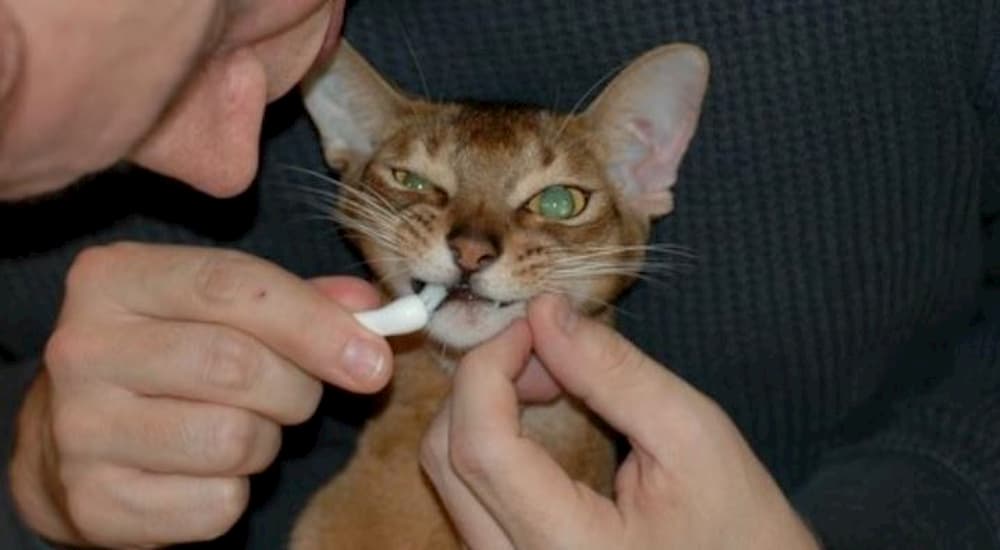Keeping your cat’s teeth clean and healthy is vital to their overall health. If you’ve ever noticed that your cat’s breath needs freshening, that smell can be a sign of poor dental hygiene. The same bacteria that cause dental disease travel through your cat’s bloodstream to cause heart, kidney, and lung disease. The most important steps to keeping your cat’s teeth clean are regular brushing and annual dental checkups with your veterinarian. Proper dental care can add years to your cat’s longevity and improve their overall health.
How Often Should You Brush Your Cat’s Teeth
While this may not be possible for some pet owners due to tight schedules or resistance from your pet, try to brush your cat’s teeth at least two to three times a week.
Choosing the Right Equipment for Brushing Cat’s Teeth
Cat-sized dental brushes with fish or chicken flavored toothpaste are available for your cat’s dental hygiene. Never use human toothpaste on your pet; it can be harmful to your cat’s digestive system due to fluoride. Your cat can safely swallow the pet brands, so no rinsing is required. Another alternative is to use a small rubber brush that fits onto your finger.
How to Brush Your Cat’s Teeth
It may take some time to get your cat acclimated to the process of brushing their teeth. Ideally, begin the process while your cat is still a kitten. However, if your cat is older, you can still get them used to the process, be patient. Follow these steps to brush your cat’s teeth:
- Hold your cat and let them get comfortable.
- Put a small amount of toothpaste on your finger and slip it into your cat’s mouth gently. Rub the outside of the teeth.
- Once your cat is comfortable with your finger in their mouth, move to the finger brush or toothbrush.
- Hold your cat’s head steady and raise the lip on one side of the mouth. Brush the outside of the teeth. Brush down from the top gum line, pushing food particles out of the mouth.
- Brush up from the lower jaw and away from the gum line.
- If your cat doesn’t open up, gently pinch her two cheeks to encourage them to open the mouth.
- Work around the mouth until you brushed the entire mouth. If your cat doesn’t tolerate brushing well, you may need several sessions to get to all the teeth.
- Allow your cat to swallow the toothpaste and have some water once finished.
- Reward your kitty with extra attention or a special treat.
Kitty insurance helps with the preventative health care costs for your pet. Learn more about what is covered by Prudent Pet health insurance.
Alternative Ways to Clean Your Cat’s Teeth
If your cat doesn’t tolerate toothbrushing, there are alternatives available. While they’re not as effective as daily brushing, they will keep your cat’s breath fresh and mouth clean. Try one or more of these options:
- Raw Bones help clean the teeth, never give cooked bones to your cat
- Teeth gels are effective anti-plaque antiseptics that bind to teeth surfaces
- Tooth wipes daily
- Add dental cleaning water additives to your cat’s bowl
- Cat breath sprays
- Treats that clean cat’s teeth
- Chew toys
Dental Disease for Cats
Unfortunately, your cat can’t tell you when they have a toothache or mouth discomfort when eating. Cats are good at hiding their pain, and you may not even know they’re suffering.These symptoms indicate that your cat may have dental problems::
- Drooling
- Loss of appetite or inability to eat
- Red, bleeding, or swollen gums
- Mouth sores
- Blood in their saliva or nasal discharge
- Batting or rubbing at the mouth
- Tilting head while eating or chewing on one side only
- Swallowing food without chewing
- Loose, broken, or missing teeth.
If you notice any of these symptoms, have your veterinarian give them a dental exam. Without proper dental care, your cat may develop infections, gingivitis, and periodontal disease. The bacteria that cause these diseases eventually enter your cat’s bloodstream and can cause more severe conditions.
Dental Cleanings for Your Cat
Your cat needs a regular checkup twice a year. At this time, your vet will check their teeth and gums and may recommend teeth cleaning. The frequency of cleanings varies, but cleaning every year or two is standard.
Your vet will evaluate your pet’s health and clear them for anesthesia. Once anesthetized, the vet puts a soft tube down your cat’s throat to keep the airway open. Your vet will take dental x-rays and clean the teeth above and below the gum line and polish them.
You may get a call at this point, telling you what the veterinarian has found and whether any additional procedures are required. Finally, the vet applies a dental sealant to prevent periodontal disease.
Cost of Cta’s Dental Cleanings
Dental cleanings are costly and can be a significant strain on the budget. Dental cleanings can cost from $300 to $1,400 or more, depending on what the dental exam reveals. Extractions or other procedures add to the cost. While this is a major expense for a pet parent, it is essential for your pet’s health.
How Pet Insurance Helps with Cat’s Dental Cleaning
One of the best ways to defray the cost of dental cleanings and other health care visits is through pet insurance. Prudent Pet offers insurance plans designed for your cat’s needs. Prudent Pet wants every pet to be healthy and happy, so they create budget-friendly programs designed to provide your cat with excellent health care without stressing your budget. An Accident +Illness plan covers dental cleanings, annual exams, accidents, and illness, as well as other health-related costs. Take a few minutes today to find out how affordable pet insurance can be.








